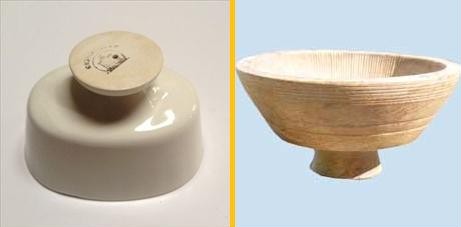
- History
- Factory Marks
- Pattern Dates
- Pattern Numbers
& Names - Newsletters
- Maling Memories Video
(free download) - A to Z Anthology
We are not responsible for links to external sites
A to Z AnthologyAs the Society no longer produces newsletters, we will post occasional items of interest here. M is for Mystery MouldMaling jelly and blancmange moulds are found from Victorian times through to the 1930s and usually bear a mark appropriate to their age. Thus our example (left) carries a version of the Cetem Ware mark suggesting a date of c1920-1930. Most moulds have a flat base but, unusually, this one has a foot. Why? As our culinary knowledge extends only as far as the soup course, we called in the Michelin-starred chefs. Kitchenalia expert Mike Appleby suggests that the shape is based on a flummery mould, but he adds that these were normally made not of pottery but wood (right). Flummery was a popular English dessert from the 17th to 19th centuries - somewhat like a blancmange. Food historian Ivan Day adds: "Flummery moulds have a little turned foot which functions as a useful handle when turning the flummery out. The moulds (usually made from water-resistant sycamore) were soaked in water before the flummery was poured in, to allow easy de-moulding."
Flummoxed by flummery? Try "J is for Jelly" instead. Want more Alphabet Soup?
|
